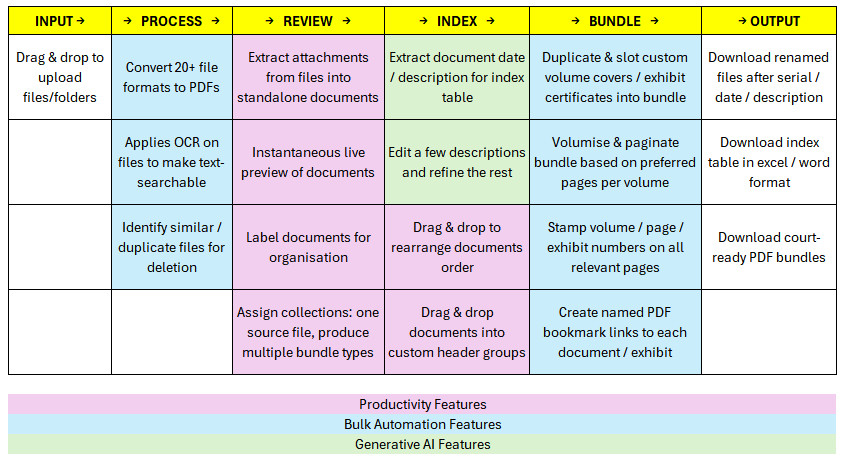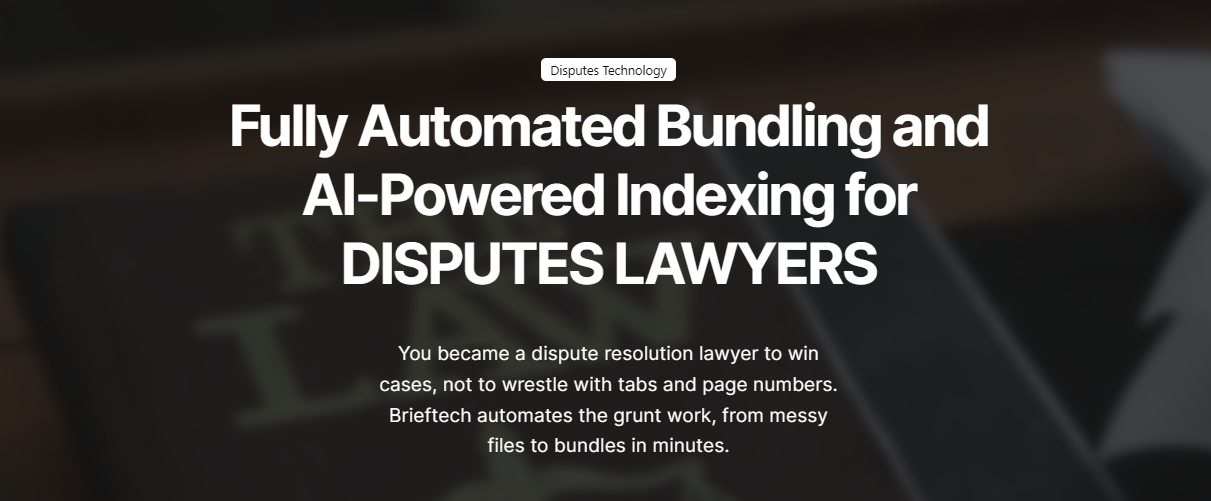Are You Ready for SG Court's Amended Affidavit Rules Starting Sep 2025? Here's How To Adapt
Here’s how to save hours preparing your court bundles while staying compliant
Thank you for subscribing
Thank you for subscribing
Thank you for subscribing

From September 2025, all three Singapore courts - the Supreme Court, State Courts, and Family Justice Courts, will implement stricter requirements on how affidavits and exhibits must be prepared.
This is based on the latest amendments to practice directions published by SG Courts.
If your team already spends late nights formatting and assembling affidavit bundles, these changes could make things even more challenging, unless you rethink how they’re being done.
The following amendments introduce stricter, more uniform requirements.
All pages must be paginated (including cover page, TOCs, separator sheets, exhibit sheets)
PDF and hard copy page numbers must match exactly
Page numbers must be inserted at the top right-hand corner of the page
Each volume must start at page 1
Every page must be numbered consecutively in every volume
This is to facilitate hearings involving reference to both hard and soft copies of the same document.
Written forms must have margins on all 4 sides: minimum of 35mm in width
Text must be printed or typed on white paper
Text of affidavits must be double-spaced (except cover page, TOCs, headings, sub-headings, reproduced contents, extracts of transcripts)
Minimum font size must be Times New Roman 12 or equivalent

On top of the new amendments, practitioners must still comply with current long-standing affidavit and exhibit rules.
Each exhibit page must be fully legible; insert magnified copies where needed
If there are more than 10 exhibits, a table of contents (index table) must be inserted before the first exhibit, in affidavit order
The exhibit index table must be set out in the sequence in which reference is made to them in the affidavit
Each exhibit must be prefaced by a dividing sheet, clearly marked with an exhibit label and the commissioner for oaths’ certificate
Each exhibit must be separately bookmarked in the PDF; bookmarks should follow the deponent’s initials (e.g. TAK-1, TAK-2)
For multiple affidavits by the same deponent in one action, exhibit numbers must continue consecutively across all affidavits
When referring to an exhibit in the affidavit, state the relevant page number(s) alongside the number of the exhibit
If an affidavit refers to exhibits in another person’s affidavit, those must also be exhibited in the deponent’s own affidavit.
On the first page (top right corner): include the party, name of deponent, ordinal number of affidavit, and filing date in a single line.
On the first page (top left corner): endorse the summons number if filed with a summons.

Anyone who has worked on affidavits knows how fragile they are:
Add or remove exhibits → entire affidavit must be re-paginated
Multi-volume affidavits → need to create new volume every 300 pages approximately
Paginate hard copy the same as PDF → need to take into account cover and index table
Hard copy doesn’t line up with the PDF → last-minute scrambling before filing
Junior lawyers, secretaries, and paralegals spend hours (sometimes days) renumbering, reformatting, and re-scanning instead of focusing on case prep
These tasks don’t win cases. But under the new rules, they become compliance-critical
The margin for error is smaller, and the cost of mistakes higher.
This is where AI-powered automation makes all the difference.
With BriefTech, affidavit preparation that once took hours can now be completed in minutes, while complying with both current practice directions and the latest amendments.
Exhibit Descriptions: Automatically generated with BriefTech's AI-indexing engine
Description Refinement: Edit a few, and AI adapts your style to refine the rest
Volumes: Auto-splits bundles based on your preferred per-volume page count
Pagination: Automatically numbers each volume from page 1
Index table: Auto-populates with exhibit references, descriptions, volumes, and page numbers
Bookmarks: Auto-names and links directly to each exhibit’s certificate page
Cover Pages: Inserts custom cover to each volume with volume number stamped
Certificates: Inserts custom certificate before each exhibit with reference number stamped
Page stamps: Applies volume-page numbers at the top right corner of every page
One-click rebuilds: Add or remove exhibits and regenerate the entire bundle in minutes
Export-ready output: Generates a full PDF e-bundle that doubles as a print-ready hard copy

Instead of pulling associates or secretaries into formatting marathons, your team can focus on the affidavit’s substance and the case strategy.
No more last-minute rushes, late-night scrambles, or tired errors that risk affidavits being rejected by the court.
👉 See it for yourself: Watch how BriefTech produces a fully compliant affidavit bundle in minutes in this short demo video.

The courts want affidavits to be consistent, accurate, and easy to navigate.
That’s fair. But meeting these standards by hand is a poor use of lawyer hours and also potentially error-prone.
If your team is still assembling affidavits manually, now is the time to rethink.
With tools like BriefTech, you’ll not only meet every new requirement, you’ll also win back the time that actually matters for clients and cases.
P.S. This article was first published on Linkedin.

Keen to learn how BriefTech’s AI-powered automation helps dispute lawyers speed up documents indexing and bundling while lowering processing costs and avoiding burnout from manual grunt work? Learn more here.

Philip Teo is a Singapore-based serial entrepreneur with deep expertise in tech startups, product development, and thought leadership.
His diverse background spans roles as a trading coach, book author, public speaker, adult education solutionist, commando soldier, expedition leader, competitive athlete, and award-winning musician.
As an early adopter of next-generation AI, Philip is on a mission to help legal professionals harness technology, optimize workflows, enhance business outcomes, and future-proof their practice.